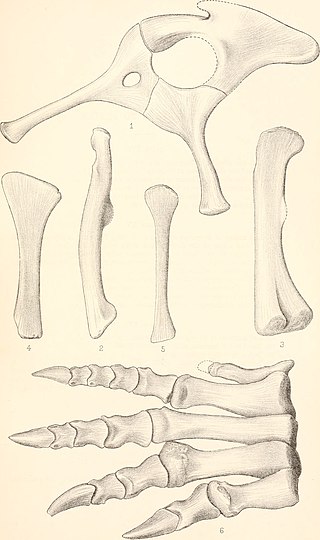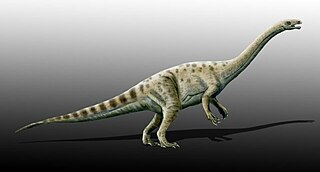
Massospondylus was a genus of sauropodomorph dinosaur from the Early Jurassic. It was described by Sir Richard Owen in 1854 from remains discovered in South Africa, and is thus one of the first dinosaurs to have been named. Fossils have since been found at other locations in South Africa, Lesotho, and Zimbabwe. Material from Arizona's Kayenta Formation, India, and Argentina has been assigned to the genus at various times, but the Arizonan and Argentinian material are now assigned to other genera.
Agrosaurus is an extinct genus of thecodontosaurid sauropodomorph probably originating from the Magnesian Conglomerate of England that was originally believed to be a Triassic prosauropod from Australia. Agrosaurus would thus be the oldest dinosaur from that country. However, this appears to have been an error, and the material actually appears to come from Thecodontosaurus or a Thecodontosaurus-like animal from Bristol, England. The type species is Agrosaurus macgillivrayi.

Euskelosaurus is a sauropodomorph dinosaur from the Late Triassic of South Africa and Lesotho. Fossils have only been recovered from the lower Elliot Formation in South Africa and Lesotho, and in one locality in Zimbabwe.

Coloradisaurus is a genus of massospondylid sauropodomorph dinosaur. It lived during the Late Triassic period in what is now La Rioja Province, Argentina. It is known from two specimens collected from the Los Colorados Formation of the Ischigualasto-Villa Unión Basin.

Gryponyx is an extinct genus of massopod sauropodomorph known from southern Free State, central South Africa.

Plateosauravus is a basal plateosaurian of uncertain affinities from the Late Triassic Elliot Formation of South Africa.

Teratosaurus is a genus of rauisuchians known from the Triassic Stubensandstein of Germany. It is estimated to be 6.2 meters (20.35 ft) long.

Efraasia is a genus of basal sauropodomorph dinosaur. It was a herbivore which lived during the middle Norian stage of the Late Triassic, around 210 million years ago, in what is now Germany. It was named in 1973 after Eberhard Fraas, who during the early twentieth century collected what were the original type specimens.

Palaeosaurus is a genus of indeterminate archosaur known from two teeth found in the Bromsgrove Sandstone Formation and also either the Magnesian Conglomerate or the Avon Fissure Fill of Clifton, Bristol, England. It has had a convoluted taxonomic history.
Rileyasuchus is a genus of phytosaur from the Rhaetian Magnesian Conglomerate of England. It has a confusing history, being associated with the taxonomy of Palaeosaurus and Thecodontosaurus, and being a replacement name for a preoccupied genus.
Sphenosaurus is a poorly known genus of procolophonid, a type of prehistoric reptile from the Late Permian Buntsanstein of Germany. Originally assigned the name Palaeosaurus sternbergii, by German paleontologist Leopold Joseph Fitzinger in 1840, the generic name was already preoccupied by not one but two other reptiles assigned the name Palaeosaurus. In 1847, Hermann von Meyer recognized the original 1833 and 1836 usages of Palaeosaurus and moved P. sternbergii to a new genus, Sphenosaurus.

Pantydraco was a genus of basal sauropodomorph dinosaur from the Late Triassic of the United Kingdom (Wales). It is based on a partial juvenile skeleton once thought to belong to Thecodontosaurus. Only one valid species of Pantydraco is recognised: P. caducus.

Thecodontosauridae is a family of basal sauropodomorph dinosaurs that are part of the Bagualosauria, known from fossil remains found exclusively in the Magnesian Conglomerate of Bristol, England, which dates back to the Rhaetian stage of the Late Triassic. Two genera are known: Agrosaurus and Thecodontosaurus; the former is often considered to be the same animal as the latter.

Massospondylidae is a family of early massopod dinosaurs that existed in Asia, Africa, North America, South America and Antarctica during the Late Triassic to the Early Jurassic periods. Several dinosaurs have been classified as massospondylids over the years. The largest cladistic analysis of early sauropodomorphs, which was presented by Apaldetti and colleagues in November 2011, found Adeopapposaurus, Coloradisaurus, Glacialisaurus, Massospondylus, Leyesaurus and Lufengosaurus to be massospondylids. This result supports many previous analyses that tested fewer taxa. However, this analysis found the two recently described North American massopods, Sarahsaurus and Seitaad, and the South African Ignavusaurus to nest outside Massospondylidae, as opposed to some provisional proposals. Earlier in 2011, Pradhania, a sauropodomorph from India, was tested for the first time in a large cladistic analysis and was found to be a relatively basal massospondylid. Mussaurus and Xixiposaurus may also be included within Massospondylidae.

Anchisauria is an extinct clade of sauropodomorph dinosaurs that lived from the Late Triassic to the Late Cretaceous. The name Anchisauria was first used Haekel and defined by Galton and Upchurch in the second edition of The Dinosauria. It is a node-based taxon containing the most recent common ancestor of Anchisaurus polyzelus and Melanorosaurus readi, and all its descendants. Galton and Upchurch assigned a family of dinosaurs to the Anchisauria: the Melanorosauridae. The more common prosauropods Plateosaurus and Massospondylus were placed in the sister clade Plateosauria.

The Melanorosauridae were a family of sauropodomorph dinosaurs which lived during the Late Triassic and Early Jurassic. The name Melanorosauridae was first coined by Friedrich von Huene in 1929. Huene assigned several families of dinosaurs to the infraorder "Prosauropoda": the Anchisauridae, the Plateosauridae, the Thecodontosauridae, and the Melanorosauridae. Since then, these families have undergone numerous revisions. Galton and Upchurch (2004) considered Camelotia, Lessemsaurus, and Melanorosaurus members of the family Melanorosauridae. A more recent study by Yates (2007) indicates that the melanorosaurids were instead early sauropods.

Asylosaurus is a genus of basal sauropodomorph dinosaur from the Late Triassic Avon Fissure Fill of England. It is based on partial remains, discovered in the autumn of 1834, described in 1836 by Henry Riley and Samuel Stutchbury as pertaining to Thecodontosaurus, that Othniel Charles Marsh brought to Yale University between 1888 and 1890. These remains thus escaped destruction by a bombardment in 1940 during World War II, unlike the original holotype of Thecodontosaurus. Asylosaurus was described in 2007 by Peter Galton. The type species is A. yalensis, referring to Yale. The bones originally came from a Rhaetian-age cave fill at Durdham Down, Clifton, Bristol.

The Magnesian Conglomerate is a geological formation in Clifton, Bristol in England, Gloucestershire and southern Wales, present in Tytherington, Durdham Down, Slickstones Quarry and Cromhall Quarry. It dates back to the Rhaetian stage of the Late Triassic, although it may be as old as the Norian stage of the Late Triassic and as young as the Hettangian stage of the Early Jurassic. This formation was first discovered in autumn 1834 and was studied in 1836 by Henry Riley and Samuel Stutchbury.
Paleontology or palaeontology is the study of prehistoric life forms on Earth through the examination of plant and animal fossils. This includes the study of body fossils, tracks (ichnites), burrows, cast-off parts, fossilised feces (coprolites), palynomorphs and chemical residues. Because humans have encountered fossils for millennia, paleontology has a long history both before and after becoming formalized as a science. This article records significant discoveries and events related to paleontology that occurred or were published in the year 1836.
The Avon Fissure Fill, also known as the Bristol Fissure Fill or Tytherington Fissure Fill, is a fissure fill in Avon, England which dates variously from the Norian and Rhaetian stages of the Late Triassic, or possibly as late as the Hettangian stage of the Early Jurassic. The fissure fill at Avon was a sinkhole formed by the dissolution of Lower Carboniferous limestones.





























